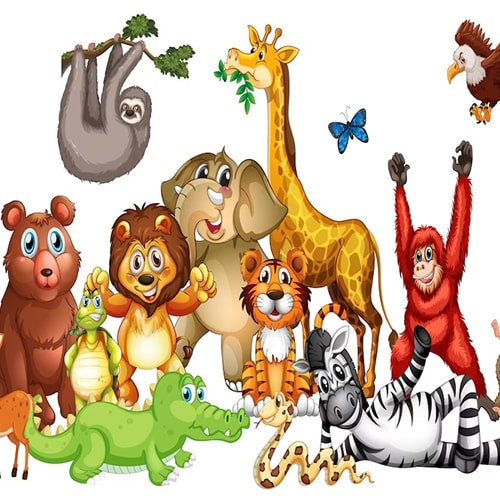Chapter 3 : Adaptations in Animals : class 4 - Science ![Adaptations in Animals class 4 - Science - questions and answers]()
Fill in the Blanks
Whales and dolphins breathe through their
lungs.
Monkeys use their
tails to balance themselves on trees.
Animals which eat both plants and animals are called
omnivorous.
Chameleon can change its colour according to its surroundings.
Parasites live inside the bodies of other animals.
Winter inactivity is also known as
hibernation.
Polar bear is adapted to live in the
polar region.Long summer sleep is also called
aestivation.
Dodo is an
extinct bird.
Name The Following…
Long sleep of some animals in winter
hibernationThe change in colour of an animal's body according to its surroundings
CamouflagingA flesh-eating animal
carnivorousAnimals which eat both plants and the flesh of other animals
omnivorous Flying animals
Aerial animalsQuestion and answers
Classify animals according to their habitats. Also mentions their important features.
Animals can be classified into five groups according to their habitats. These are- Terrestrial animals, Aquatic animals, Amphibians, Arboreal animals, Aerial animals
a. Terrestrial animals - i) These animals have strong legs to run fast, to accept and to catch their prey.
ii) They have well developed sense organs that help them to hunt other animals and to protect themselves from their enemies.
b. Aquatic animals -i) They have fins or paddles which help them to swim.
ii) Most aquatic animals breathe through their gills.
c. Amphibians -i) they breathe through their lungs when they are on land and they breathe through their moist skin when they are in water.
ii) These animals have webbed feet which help them to swim.
d. Arboreal animals -i) They have special claws, strong arms and legs which help them to climb trees.
ii) Some animals have very long tails. They use their long tail to hold on to the branches of a tree when they swing from one tree to another.
e. Aerial animals -i) Most of the aerial animals have wings and body feathers.
ii) They have hollow bones which make their body very light.
What is the difference between hibernation and aestivation?
Long summer sleep of the desert animals is called aestivation while sleep or inactivity of some animals are called hibernation.
What is camouflage?
The ability of some animals to blend with their surroundings is called camouflage.
How can animals be grouped according to their food habits?
Animals can be classified in five main groups according to the food they eat.
Herbivores
Carnivores
Scavengers
Omnivores
Parasites
How are animals Classified on the basis of presence or absence of the backbone in their bodies?
Animals can be classified on the basis of presence or absence of the backbone in their bodies in two types….
Invertebrates or non chordates
[Ex.- Worms, Insects, Spiders, Snails, Slugs, etc.]
Vertebrates or chordates
[Ex.- Fishes, Amphibians Reptiles, Birds, Mammals]
How do animals protect themselves from their enemies?
Different animals protect themselves differently…
Some animals have strong legs that enable them to run very fast to escape from their enemies. Turtles and snails have very hard shells on their bodies. When they face danger they get into their hard shells.
The Porcupine has very sharp quills on its body. Other animals do not attack it due to the fear of their quills.
What do you mean by scavengers?
Animals that eat the flesh of dead animals are called scavengers,
Ex:- Hyena, Jackal, vulture etc.
What are parasites?
Animals that depend on other living animals for their food are called parasites.
Ex : lice, hookworms, fleas etc.
What do you mean by cold-blooded animals?
Animal whose body temperature changes according to the temperature of their surroundings.
Ex : Reptiles, Amphibians.
How are animals classified on the basis of presence or absence of the back bone in their bodies?
Animals
| Invertebrates (Non-chordates) | Vertebrates (chordates) |
|---|
Worms
Insects
Spiders
Snails
Slugs
| Fishes
Amphibians
Reptiles
Birds
Mammals
|
Differentiate between amphibians and aerial animals.
| Amphibians | Aerial animals |
|---|
| i) The animals that can live both on land and in water are called amphibians. | i) Animals that can. fly and spend a lot of time in the air are called aerial animal |
| ii) They have webbed feet which help them to swim in water. | ii) They have wings and body feathers. |
| iii) Examples- frog, newt. | iii) Examples-Birds, bats. |
Differentiate between Endangered and extinct animals.
| Endangered animals | Extinct animals |
|---|
| Animals that are in danger of becoming extinct are called endangered animal | Some animals have disappeared from the Earth. Such animals are called extinct animal |
| Giant pandas, Snow leopards, and Asian elephants are some endangered animals. | Dodo, tapir, passenger Pigeon are some extinct animals. |


